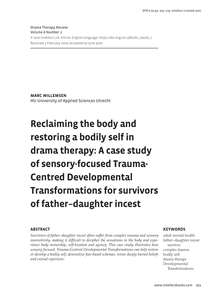When planning a study measuring the effects of a neurodevelopmental treatment (NDT), we were confronted with the methodological problem that while measuring the effects of NDT, a rival hypothesis is that the decision to implement the NDT might be related to the quality of nursing care. Therefore, we measured the quality of nursing care as a possible confounding variable in relation to this outcome study. The quality of nursing care was measured on 12 wards participating in the experimental and control groups of the outcome study. Data were collected from 125 patients and 71 nurses and patients' records. The findings showed no significant differences in the quality of nursing care between the 2 groups of wards (P = .49). This method may be useful to other researchers conducting outcome research and who are confronted with a similar methodological problem.
DOCUMENT

Survivors of father–daughter incest often suffer from complex trauma and sensory insensitivity, making it difficult to decipher the sensations in the body and experience body ownership, self-location and agency. This case study illustrates how sensory focused, Trauma-Centred Developmental Transformations can help restore or develop a bodily self, desensitize fear-based schemas, revise deeply buried beliefs and extend repertoire.
DOCUMENT

Background: Neurodevelopmental treatment (NDT) is a rehabilitation approach increasingly used in the care of stroke patients, although no evidence has been provided for its efficacy. Objective: To investigate the effects of NDT on the functional status and quality of life (QoL) of patients with stroke during one year after stroke onset. Methods: 324 consecutive patients with stroke from 12 Dutch hospitals were included in a prospective, non-randomised, parallel group study. In the experimental group (n = 223), nurses and physiotherapists from six neurological wards used the NDT approach, while conventional treatment was used in six control wards (n = 101). Functional status was assessed by the Barthel index. Primary outcome was poor outcome, defined as Barthel index ,12 or death after one year. QoL was assessed with the 30 item version of the sickness impact profile (SA-SIP30) and the visual analogue scale. Results: At 12 months, 59 patients (27%) in the NDT group and 24 (24%) in the non-NDT group had poor outcome (corresponding adjusted odds ratio = 1.7 (95% confidence interval, 0.8 to 3.5)). At discharge the adjusted odds ratio was 0.8 (0.4 to 1.5) and after six months it was 1.6 (0.8 to 3.2). Adjusted mean differences in the two QoL measures showed no significant differences between the study groups at six or 12 months after stroke onset. Conclusions: The NDT approach was not found effective in the care of stroke patients in the hospital setting. Health care professionals need to reconsider the use of this approach.
DOCUMENT
